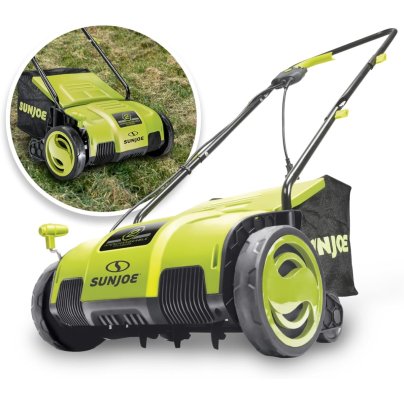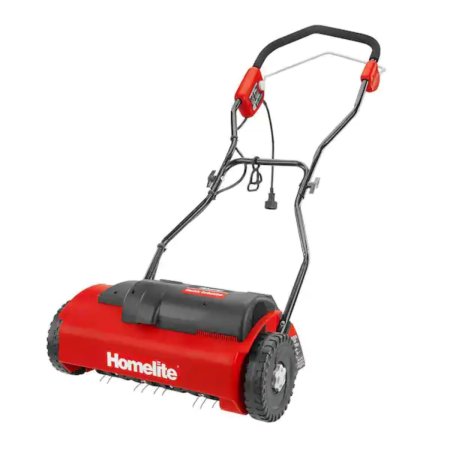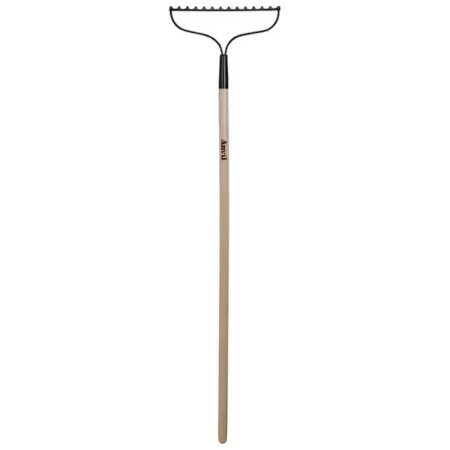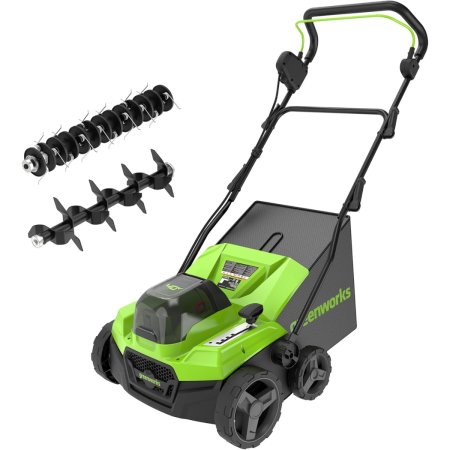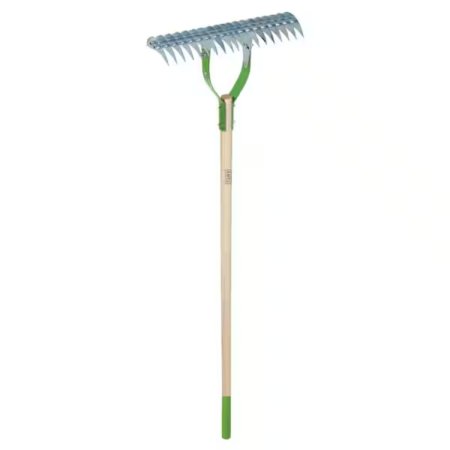
We may earn revenue from the products available on this page and participate in affiliate programs. Learn More ›
It takes hard work to cultivate a healthy lawn you can be proud of, but using a lawn dethatcher can make it a whole lot easier. Thatch, the thick layer of organic buildup between grass and the ground soil, can prevent new seedlings from emerging and growing, but a good lawn dethatcher can help loosen that thatch.
We recently put six different lawn dethatchers to the test, removing large amounts of thatch from our test lawn to find out which models performed best. Our favorite model is the Homelite 14″ Electric Lawn Dethatcher, which excels at removing thatch and comes with a reasonable price tag. Below, read more about our findings and learn what you’ll want to look for when choosing from the best lawn dethatchers.
- BEST OVERALL: Homelite 14″ Electric Dethatcher
↓ Jump to Review - RUNNER-UP: Sun Joe 12.6″ Electric Lawn Dethatcher + Scarifier
↓ Jump to Review - BEST BANG FOR THE BUCK: Anvil 51″ Wood Handle Steel 14-Tine Bow Rake
↓ Jump to Review - UPGRADE PICK: Greenworks 15″ 40V Cordless Dethatcher/Scarifier
↓ Jump to Review - BEST MANUAL: Ames 15″ Adjustable Thatch Rake
↓ Jump to Review
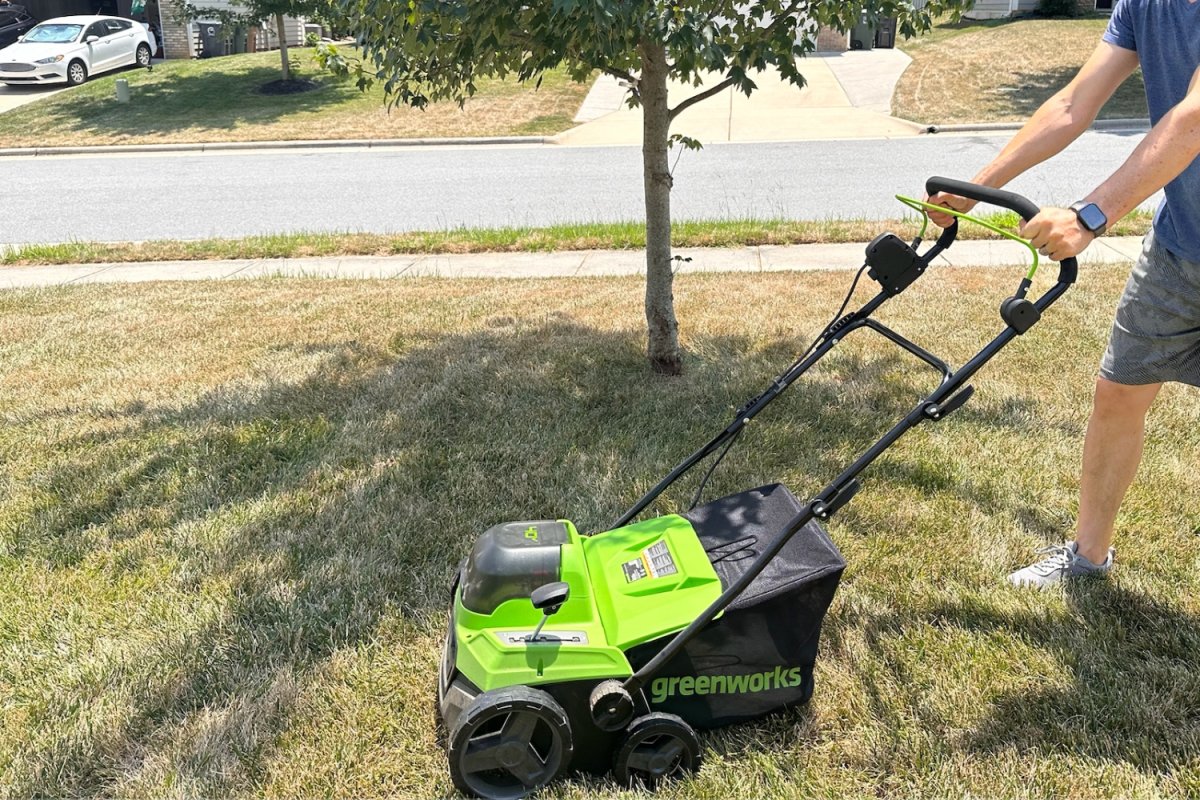
| Testing Stats | |
| Products tested | 6 |
| Time spent testing | 3 hours |
| Tests performed | 1 |
| Price range | $15 to $250 |
Our Top Picks
Thick thatch can prevent sunlight from reaching the grass seedlings underneath, but this roundup will shed some light on some of the best lawn dethatchers to mitigate that. The list includes options for nearly any yard size.
Best Overall
Homelite 14" Electric Dethatcher
Product Specs
- Type: Electric
- Dethatching width: 14 inches
- Weight: 30.8 pounds
Our Ratings: Ease of Use 4/5; Effectiveness 5/5; Durability 4/5; Value 4.5/5
What We Like
- Lightweight design makes it easy to push
- Collects an ample amount of thatch
- Easy-to-operate controls
What We Don’t Like
- Doesn’t double as a scarifier
We loved the power of this dethatching machine. Despite having a small 10-amp motor, it did a tremendous job of pulling up dead grass. It removed just as much thatch as other higher-powered models we tested. We experienced no clogging or bogging down, and it did minimal damage to the lawn. Plus, its light weight made it easy to push, and the deck controls on the wheel allowed for quick height adjustments. And like the other electric dethatchers we tested, it operated very quietly.
The Homelite lacks a bagging attachment, which is something all the other electric dethatchers we tested come with. But since none of the collection bags on the other electric dethatchers we tested actually worked, we didn’t hold that against the Homelite.
We should note that the Homelite is only a dethatcher (other dethatchers we tested can double as scarifiers), so it won’t offer you the option to dig deeper into the soil to remove moss and aerate your lawn. This was disappointing, especially since the Homelite costs about the same as dethatchers that have this function. Still, that doesn’t discount the fact that the Homelite is one of the best-performing electric dethatchers we tested.
Get the Homelite lawn dethatcher at The Home Depot.
Runner-up
Sun Joe 12.6" Electric Lawn Dethatcher + Scarifier
Product Specs
- Type: Electric
- Dethatching width: 12.6 inches
- Weight: 21 pounds
Our Ratings: Ease of Use 4.5/5; Effectiveness 5/5; Durability 4/5; Value 4.5/5
What We Like
- Impressive thatch-removing power
- Light overall weight makes it easy to push
- Doubles as a scarifier
What We Don’t Like
- Bagging attachment is essentially useless
Sun Joe’s dethatcher for lawn use is small but mighty, which is exactly what most of us want out of this type of machine. Thanks to its powerful 12-amp motor, it pulled up a tremendous amount of thatch with each pass we made. And making passes with it wasn’t difficult since it only weighs 21 pounds. When equipped with its scarifier, the Sun Joe dethatcher generated so much thatch-removing power that we had to be mindful of the height adjustment, something we realized when we scalped a small patch of grass. Even with thicker grass, the motor had no trouble moving across the lawn, nor did it stall out at any point.
The Sun Joe does come with a bagging attachment, but it is essentially useless. Very little thatch actually ended up in the bag, and because the bag is so small, we would have had to stop every 10 feet or so to empty it if the thatch had successfully collected inside of it. In the end, it was more efficient to rake up the dead grass or go over it with a lawn sweeper to collect it. The useless bagging attachment would be a bigger strike against the Sun Joe if any of the bagging attachments on the three electric dethatchers we tested that came with them actually worked. None did.
Get the Sun Joe lawn dethatcher at Amazon.
Best Bang For The Buck
Anvil 51" Wood Handle Steel 14-Tine Bow Rake
Product Specs
- Type: Manual
- Dethatching width: 13.6 inches
- Weight: 2.6 pounds
Our Ratings: Ease of Use 4.5/5; Effectiveness 5/5; Durability 4/5; Value 4.5/5
What We Like
- More affordable than a specialized dethatching rake
- Can be used for other gardening tasks
- Heavy-duty construction
What We Don’t Like
- Harder to use than a standard dethatching rake
For a tool that isn’t specially designed to remove thatch, the Anvil 51-inch rake surprised us with how well it performed at this task. After experimenting with the amount of pressure to apply and the angle at which to hold it, we found that the Anvil metal rake pulled up thatch nicely. It’s also durably made with a thick wooden handle and iron head. No, it isn’t as efficient as a specialized dethatching rake, and it tends to pull up a higher percentage of casualties in the form of healthy grass. Just be prepared to get an upper body workout when using it for dethatching.
That said, it’s effective enough to make it a good option if you have a small area to dethatch, don’t want to pay for a specialized dethatching rake, or simply don’t relish the idea of crowding your shed with yet another single-purpose lawn and garden tool. And unlike a rake designed specifically for dethatching, a metal rake is a gardening essential, useful for a variety of jobs such as spreading mulch, cultivating soil, and gathering up leaves and debris.
Get the Anvil lawn dethatcher at The Home Depot or Walmart.
Upgrade Pick
Greenworks 15" 40V Cordless Dethatcher/Scarifier
Product Specs
- Type: Motorized
- Dethatching width: 15 inches
- Weight: 26.5 pounds (without battery)
Our Ratings: Ease of Use 4.5/5; Effectiveness 5/5; Durability 4/5; Value 4/5
What We Like
- Cordless design expands range
- Removes a lot of thatch with each pass
- Depth adjustment allows for easy modifications
What We Don’t Like
- Bagging attachment is useless
This battery-powered dethatcher from Greenworks is certainly pricey, especially once you add in the cost of a 40-volt battery and charger (it costs twice as much as a corded dethatcher). But if you’re serious about dethatching and want to free yourself from the constraints of a cord, it’s worth the additional investment.
The Greenworks dethatcher is a beast, performing just as well as (if not better than) the corded models we tested. We had no problem pulling up armfuls of thatch with each step we took. And since it only weighs 26.5 pounds, it’s easy to push. The intuitive controls are simple to use. A large depth-adjustment knob on the top of the dethatcher allowed us to switch between its five different depth levels with ease.
We did have the same gripe with the Greenworks dethatcher as we had with all the electric models we tested: The included bagger attachment is useless. It fills up so quickly that it needs to be emptied after only a few steps. It worked far better when we removed the bagger and left the dead grass to be raked up later. Bagging issues aside, if you don’t mind its steep price tag, the Greenworks is truly the way to go to dethatch your yard.
Get the Greenworks lawn dethatcher at Amazon, Walmart (battery and charger included), or Greenworks (battery and charger included).
Best Manual
Ames 15" Adjustable Thatch Rake
Product Specs
- Type: Manual
- Dethatching width: 14.3 inches
- Weight: 4.5 pounds
Our Ratings: Ease of Use 4/5; Effectiveness 4.5/5; Durability 5/5; Value 4.5/5
What We Like
- Head angle is adjustable
- Does minimal damage to lawns
- Tines pull thatch from grass effectively
What We Don’t Like
- A little on the heavy side
For an affordable alternative to all the expensive electric dethatchers out there, the Ames dethatching rake is a good option. The head bites into the grass nicely, allowing you to pull up a considerable amount of thatch with each swipe. This dethatching tool also allows you to adjust the angle of the head, which we found very useful during testing. On our first few attempts, we pulled up an alarming amount of healthy turf. But after making a few adjustments to the angle to make it less aggressive, we were able to mitigate that problem, limiting the material we removed to mostly yellow and brownish thatch.
After testing several manual dethatching rakes, we do have some gripes with this one’s handle. While we like the durability of the wood, it adds weight that makes what is already a taxing job into an even more arduous ordeal. We also would have liked the handle to be longer, which would have allowed us to get more leverage on the blade to deliver greater thatch-removing power with less effort. That aside, the Ames hand dethatcher is a great manual option for removing thatch if a motorized dethatcher isn’t in the budget.
Get the Ames lawn dethatcher at Amazon, The Home Depot, or Walmart.
ALSO TESTED
LawnMaster 16″ Electric Scarifier & Lawn Dethatcher: We had high hopes for the LawnMaster, but it failed miserably during testing. It consistently clogged and shut itself off after just a few seconds of running, forcing us to lift the front end off to clear out thatch.
Jump to Our Top Picks
How We Tested the Best Lawn Dethatchers
We put our six dethatchers to the test on a yard with moderate thatch, using each model on an area of the same size. During testing, we started our analysis by noting how easy the dethatcher was to set up. We then assessed how effectively each one removed thatch by collecting and comparing the amount of thatch each pulled up. We also considered the amount of collateral damage each model inflicted on healthy grass. After completing our testing, we assessed value by comparing the dethatcher’s price to its overall performance.
What to Consider When Choosing a Lawn Dethatcher
Choosing the best dethatcher to rejuvenate your lawn involves quite a few factors. This section will outline some of the most important considerations to keep in mind while evaluating the various options. This will help you find the best machine to dethatch your lawn based on its size and your existing lawn equipment.
Types of Dethatchers
Before you start shopping for the best lawn dethatcher, it’s important to understand the different styles of dethatchers on the market.
Motorized
Motorized dethatchers look just like small lawn mowers. They have motors that power small, spinning dethatching tines designed to dig and loosen the thatch. This type of dethatcher either runs off a rechargeable battery or AC power, requiring an outdoor power supply nearby or a long extension cord.
Tow-Behind
These dethatchers attach to the hitch on the back of a lawn mower, tractor, four-wheeler, or side-by-side, making them ideal for covering large areas. As one of these motorized machines pulls the dethatcher across the lawn, it loosens up the thatch quickly and easily.
Attachments
Like tow-behind dethatchers, attachments can temporarily convert other lawn tools, such as a lawn mower, into a dethatcher. This can require a little bit of work, since the user will need to replace the mower blades with dethatching blades. Most mower attachments fit 20-inch decks. For best results, consult the attachment information provided by the manufacturer of the dethatcher blades.
Manual
If you don’t mind a bit of hard work, you can save substantial money and go for a manual dethatcher. This tool looks very similar to a standard yard rake, and it allows users to focus their efforts on small areas to ensure they can get to all the thatch. These dethatching tools are best for dethatching smaller areas.
Tines
The tines are the small fingerlike prongs that dig into the thatch to loosen it. The number of tines included on any dethatcher type typically depends on the width of the machine. As the tines rotate around the shaft or are pulled through the yard, they dig into the thatch, lift it, and break it up. Stainless steel and spring-steel tines are the best because they’re strong and resistant to the effects of corrosion.
Dethatcher Width
When it comes to choosing the best lawn dethatcher, keep in mind that the tools come in different widths. They range from about 12 inches to more than 48 inches wide, offering a variety of choices for small yards as well as large properties.
The larger the dethatcher’s width, the fewer passes it will have to make to cover the property. Keep in mind that it can be difficult to maneuver a larger dethatcher through narrow paths weaving through the property, such as between trees or gates. Consider the narrowest parts of the property before selecting a dethatcher.
Additional Features
Some dethatcher machines have additional features that might help make your decision easier. Many of the best lawn dethatchers are height adjustable, allowing the tines to sink deeper into thick thatch or run higher and smoother over a thin type of grass. This can be a significant benefit for lawn aeration, particularly if the thatch thickness varies significantly throughout the lawn.
Some tow-behind dethatchers have levers that lift and lower the tines into the grass. This is a handy feature when crossing over driveways or pathways. The user can lift the tines without having to get off the tractor and then lower them back down when clear of the pavement or concrete.
FAQs
If you still have some questions about the best lawn dethatcher, this section is for you. It’s a collection of some of the most frequently asked questions about grass dethatchers, so be sure to check for an answer to your question listed below.
Similar to a power rake, a lawn dethatcher is a gardening tool used to remove thatch from a lawn. Thatch is a layer of dead grass, moss, leaves, and other organic material that accumulates between grass and the soil surface. While a thin thatch layer is beneficial for a lawn as it can provide insulation and protection, excessive thatch can hinder the healthy growth of grass by preventing water, air, and nutrients from reaching the soil and the roots of the grass.
A dethatcher loosens and removes thatch from the lawn, improving airflow and nutrient absorption.
There aren’t many differences between a scarifier and a dethatcher. The main difference is that a scarifier digs deeper into the thatch, moss, and soil below the surface. Dethatchers simply loosen and remove the clippings and leaves.
It’s best to dethatch your lawn twice a year: once in the spring after snow has packed the thatch down and once in the fall before snow settles on the new thatch.
Dethatching your lawn can be rough on the grass left behind, so it’s best to fertilize right after dethatching to help the grass recover.
Dethatch in September when the weather begins to cool. This is when lawns tend to grow fastest and are best able to endure the stress and damage caused by dethatching.
Meet the Tester
Tony Carrick is a freelance writer specializing in home improvement, landscaping, technology, home security, and design. Carrick has conducted rigorous product testing on everything from power tools to home security systems to backyard grills. With each review, his goal is to help readers determine whether a product meets their needs and if it is or isn’t worth its price tag.
Additional research provided by Tom Scalisi.

